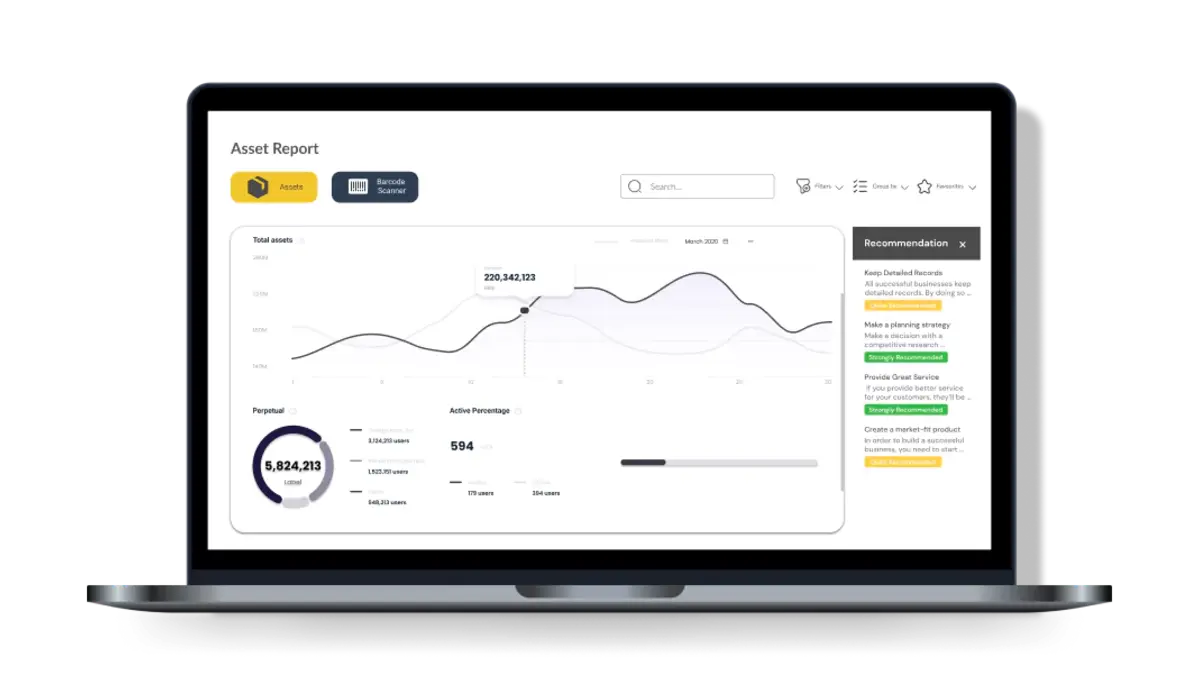Asset Management Software is a system that helps businesses keep track of all their tools and machines in one central place. It uses a central database where you can monitor, maintain, and manage all assets, from vehicles to office gadgets, making repairs and replacements easier.
In the Philippines, where the growth of businesses often relies on the efficient management of assets, the reality of asset mismanagement can be shocking.
Consider a local delivery company that loses track of its fleet’s maintenance schedules, leading to frequent breakdowns and delayed deliveries. Not only does it interrupt operations, but also impacts customer satisfaction and the bottom line.
Asset management software is crucial, offering a solution that transforms chaos into order. It helps track essential items like cars and machines, ensuring they’re well-maintained and ready to use. This allows businesses to run smoothly and quickly adapt to new opportunities.
In this article, we’ll examine the benefits of asset management software for businesses in the Philippines. These systems can make asset management easier, improve operations, and support continuous growth.
Table of Contents

Key Takeaways
|
Common Problems and Challenges in Asset Management
Businesses in the Philippines need help with asset management, often leading to inefficiency and loss. One common issue is the need for real-time tracking, which can cause delays and mismanagement.
Another significant challenge is the high cost of maintenance and repairs due to poor asset tracking. Companies can spend more on emergency repairs than scheduled maintenance with proper asset management.
These statistics show the importance of proper asset management. Businesses need to implement asset management software to overcome these challenges. This software provides real-time tracking, accurate records, and predictive maintenance schedules, reducing costs and improving efficiency.
By adopting such systems, companies can ensure better organization and utilization of their assets, leading to smoother operations and increased profitability.
Check out our other article about the best asset management software in the Philippines for help choosing the perfect fixed asset management system for your business.
8 Main Benefits of Using Asset Management Software
Enterprise asset management software helps businesses track all their assets. It provides a central database where you can monitor, maintain, and manage everything from vehicles to office gadgets, making it easier to handle repairs and replacements.
To be more detailed, Asset Management Software (AMS) offers several key benefits, which are:
1. Reduce downtime
Asset management software helps reduce downtime by predicting when machines might break and scheduling maintenance before problems happen. Studies show that such software can reduce the average downtime of 800 hours annually by anticipating issues and planning maintenance.
This software also helps companies track all their tools and machines, ensuring nothing gets lost or stolen. By keeping everything organized, businesses can save money and avoid buying things they already have, which has been proven to reduce expenses by 15-20%.
2. Reduce risk
One of the benefits of asset management software is supporting businesses in obeying regulations and in identifying potential issues early on. This approach contributes to a safer work environment and can enhance operational efficiency by 10-15%.
BCG notes that deploying AI in risk management helps avoid legal complications, improves regulation obedience by 10-15%, and bolsters a company’s reputation for safety and reliability.
3. Better asset visibility
As companies grow, managing assets manually becomes more complex. Asset management software, integrated with asset performance management features, consolidates asset information, providing a detailed view of each item and helping optimize its performance.
Real-time asset tracking reduces the time spent searching for equipment, thus enhancing productivity. Asset management software offers real-time location tracking, which improves coordination and workflow. BCG reports that businesses using these technologies can see a 10-15% improvement in operational performance.
This central repository is vital for quick, informed decision-making. KPMG’s survey indicates that 85% of asset managers consider improved visibility crucial for fine-tuning maintenance schedules and minimizing downtime.
4. Improved equipment maintenance
Regular equipment maintenance is crucial for the reliability of vehicles, machinery, and industrial equipment. Asset management software documents every maintenance activity, ensuring adherence to legal standards and enhancing equipment reliability.
Knowing assets’ lifecycles is key to their efficient management. The asset management software provides performance insights, aiding in the optimization of procurement to disposal processes. StartUs Insights reveals that comprehensive lifecycle management can lower the total cost of ownership by 10-20%.
Deloitte and KPMG emphasize that businesses utilizing these tools can reduce maintenance costs by 25-30% through timely repairs and preventive actions.
5. Eliminate ghost asset
One of the overlooked benefits of asset tracking systems is that they help minimize the existence of ghost assets in companies. Ghost assets, which are listed but not physically present, can lead to inflated costs and complex record-keeping.
Asset management software assists in identifying and rectifying these discrepancies, potentially saving up to 15% in related costs by avoiding unnecessary tax and insurance expenses.
6. Improve work-in-process (WIP) tracking
One benefit of using an asset tracking system is improving WIP tracking. Tracking ongoing work ensures assets are used efficiently and projects are completed on schedule. Asset management software updates task progress, helping identify and resolve bottlenecks.
Based on KPMG reports, enhanced work-in-process tracking using asset management software can increase project efficiency by 20-25%.
7. Reduce loss
Asset management software implements processes for tracking and rotating inventory, which reduces the likelihood of loss due to theft, misplacement, or expiration.
Accurate inventory records and security measures significantly lower the risk of asset loss. McKinsey estimates that businesses using these solutions can see a 20-25% reduction in asset loss costs.
If you’re curious about how asset management software can reduce asset loss costs, you can try the HashMicro asset management system, which has comprehensive features. Download the price scheme below to see the full potential.
8. Makes asset audits easier
One of the benefits of asset tracking is that it makes audits easier. Accurate and current records maintained by asset management software make the audit process more efficient, ensuring easy compliance verification and reducing the time and effort needed for audits.
KPMG points out that automated reporting can enhance audit efficiency by up to 30%, allowing businesses to focus more on strategic initiatives.
Selecting the Right Asset Management Software for Your Business
Selecting the ideal asset management software is a pivotal choice that can significantly influence how you manage your company’s assets and overall success. When choosing the best software for your needs, think about these features:
- Asset tracking: The software must monitor all assets, including online attendance, providing real-time insights into location, condition, and maintenance needs.
- User-friendly: Choose user-friendly software that simplifies tasks, making information retrieval and report generation accessible for all users.
- Compatibility: Ensure the software integrates with your OS, language, hardware, and data formats. The best software offers customization for your specific needs.
- Scalability: Choose software that supports growth and allows easy, cost-effective upgrades. Ensure the provider offers robust support.
- Tailored solutions: The software should meet your specific operational needs. Before searching, create a checklist of required features.
- Mobile accessibility: The software must perform well on mobile platforms and have a user-friendly interface across various devices.
- Comprehensive coverage: The software should cover all your assets, from vehicles to office gadgets. When choosing a software package, consider the scope of your asset inventory.
By considering these aspects and strategies, you can pick the best asset management software that meets your business requirements, improves your asset management practices, and aids in the growth and prosperity of your business.
Also read: Top Manufacturing Asset Management Software
Boost Your Asset Management with HashMicro
HashMicro’s Asset Management Software is the go-to solution for businesses looking to manage their assets effectively in the Philippines. It provides a central place to track, maintain, and manage all assets, making handling repairs, replacements, and overall organization easier.
This vendor also offers free demo access for prospective clients interested in exploring their software. This allows you to experience all the features and benefits without any upfront commitment. It’s an excellent opportunity to see how HashMicro, trusted by over 1,750 clients across different Southeast Asian sectors, can help manage your business assets.
Asset Management Software from HashMicro solves asset management problems by providing real-time tracking, reducing downtime, and ensuring better organization. It helps manage maintenance schedules, prevents asset loss, and simplifies audits.
Here are some key features that HashMicro’s Asset Management Software includes:
- Asset maintenance budget: This software lets companies set and track budgets for maintaining assets, ensuring financial resources are used efficiently.
- Preventive maintenance scheduling: Allows businesses to plan regular maintenance ahead of time, reducing unexpected breakdowns and extending asset life.
- Asset stock taken with barcode: Barcodes track asset quantities quickly and accurately, simplifying inventory management.
- Asset GPS tracking: This software provides real-time monitoring of asset locations, which is especially helpful for companies with assets in multiple places.
- Parent and child asset management: This feature involves managing complex assets by tracking individual components and their relationships to the main asset.
- Fuel log & odometer tracking: This feature monitors fuel usage and mileage for better maintenance and cost analysis. It is helpful for businesses with vehicles.
- Repair order management: Integrates with inventory management to handle repair orders efficiently, ensuring timely maintenance and stock control.
Conclusion
The benefits of asset management software are clear for Philippine businesses. It improves precision and efficiency, offers real-time insights into assets, and helps companies meet industry rules. With these benefits, managing company assets will be optimal.
Companies looking for an all-in-one asset management solution will find HashMicro’s Asset Management Software a dependable and effective option. With HashMicro, businesses gain access to a suite of advanced features.
These include offering seamless integration, intelligent maintenance scheduling, and insightful analytics. Such tools empower businesses to fine-tune their approach to asset management and achieve their goals with greater assurance.
See how HashMicro can transform your approach to asset performance management. Try the free demo and watch your business thrive!
FAQ about Benefits of Asset Management Software
-
How does asset management software enhance operational productivity?
Asset management software significantly boosts operational productivity by enabling efficient asset tracking. This allows teams to focus more on their core tasks instead of spending time tracking down equipment.
The system’s real-time data facilitates informed decisions about asset allocation and project scheduling, optimizing operations and enhancing productivity.
-
Can asset management software help in reducing maintenance costs?
Asset management software helps reduce maintenance costs by facilitating proactive maintenance strategies. This approach extends the lifespan of assets and prevents costly emergency repairs, thus saving a substantial amount of money in the long run.
-
How does asset management software contribute to cost efficiency?
Asset management software enhances cost efficiency by preventing asset misplacement, underutilization, and theft, saving high costs. Moreover, accurate data on asset conditions allows for planned maintenance, which is more cost effective than reactive maintenance.
-
What are the advantages of integrating asset management software with ERP systems?
Integrating asset management software with ERP systems provides comprehensive asset lifecycle management, from acquisition to disposal. This integration helps track maintenance costs, depreciation, and even disposal of assets, thus enabling better financial planning and decision-making.
It also enhances data accuracy by ensuring consistency across operational and economic systems, which is crucial for informed decision-making.
-
What role does asset management software play in improving project success rates?
Efficient asset management is crucial for project success. The software provides a clear, real-time picture of all assets, which helps maintain accurate project schedules, manage resources effectively, and respond swiftly to any issues that may arise. This increases the overall success rate of projects.























